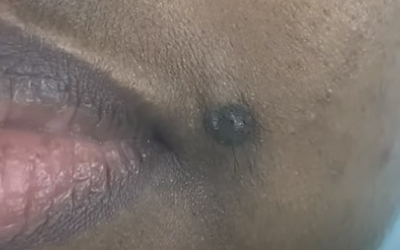Mole Removal Surgery
Mole Removal Surgery can be done by cutting with or without stitches; and shave removal using a scalpel blade without stitches.
Some facts about Mole Removal Surgery:
- A mole is referred as any dark spot or irregularity in the skin.
- Your doctor will do a surgical procedure to remove the mole if it is cancerous.
- You may want to have the mole removed if it is causing irritation when you shave.
- Mole removal is usually done on an outpatient basis and takes only a short time.
- Your doctor will numbs the area around the mole and cuts it out. A margin of healthy skin will also be removed along with the mole if necessary.
- See your doctor promptly if you notice that a mole has grown back.

Preparation for Mole Removal Surgery:
- A dermatologist can help for diagnosis of a mole to know if it is normal or needs further investigation.
- Any changes you have noticed or any new symptoms you are experiencing because of the mole should be listed before visiting the doctor.
- A list of all medications, vitamins or supplements that you are taking should be prepared.
- The location of the lesion and the date of removal must be noted if you have had a melanoma or a mole removed in the past.
- Also bring the biopsy report if you have.
- The area to be treated will be cleansed by using either alcohol, Betadine, or another suitable material depending on the preferences of the surgeon.
- An anesthetic, such as lidocaine will be used to numb the area to be treated.
- A sterile drape may be placed over the area to be treated depending on the size of mole and method used for excision, although the procedure does not need to be done in a sterile environment.
Procedure for Mole Removal Surgery:
Usually the mole will be removed by a dermatologist in a single office visit. However, second appointment is necessary sometimes.
There are usually two primary procedures used to remove moles. This include Shave excision and Surgical excision.
Shave excision:
- A thin, razor like tool will be used by your dermatologist to carefully slice away the mole during this procedure.
- Electrosurgical feathering will be performed by using a device with a tiny electrode at the end.
- The appearance of the excision can be minimized by blending the edges of the wound with the surrounding skin by this feathering.
- Stitches are not required after a shave excision.
- Usually the mole is examined under a microscope after the procedure to check for signs of skin cancer.
Surgical excision.:
- Surgical excision is like traditional surgery which is deeper than a shave excision.
- The entire mole and below to the subcutaneous fat layer will be cut out by the dermatologist during this procedure.
- A scalpel will be used to cut the mole and a border surrounding the mole.
- The border size depends on the concern of the surgeon for the mole being removed which will be larger if there is concern that the mole could be precancerous or cancerous.
- A larger border will be removed so that it can be ensured that the mole itself is completely removed.
- Stitches are placed either deep or on the upper surface of the skin depending on the depth of the mole.
- Usually the mole is examined under a microscope after the procedure for cancer cells.
Mole removal should not be tried by yourself as the risks of infection and bad scarring are too high and you may leave cancer cells behind if the mole was cancerous.
Laser excision can be performed or small moles. But it is not a choice for deep moles as the laser light doesn't penetrate deeply enough, and there is no tissue remaining to examine pathologically. Excision with or without stitches is mostly preferred by the dermatologist, depending on the depth of the mole and the type of cosmetic outcome desired.
Risks of Mole Removal:
- Infection is the most common risk for the removal of mole. Anesthetic allergy is rare and nerve damage is very rare.
- The risks associated with the procedure of removal of mole can be decreased by choosing a dermatologist or surgeon with appropriate skills and experience with these removals.
- The risks also varies depending on the area being treated and the method of removal.
- Formation of scar is the most common difficulties after mole removal.
- An idea of the type of scar after mole removal can be given by your surgeon before you make your decision about removal.
Recovery from Mole Removal Surgery:
- Surgical removal of a mole, either for cosmetic reasons or because the mole is cancerous, will result in a scar.
- However, the resulting scar may disappear on its own depending on your age, the type of surgery and the location of the mole.
- A variety of products and methods can be used to minimize a mole removal scar.
- Scarring can also be abnormal, resulting in large scars.
- It is called as a hypertrophic scar, when the body makes too much collagen during the healing process.
- Keloid scar is an abnormal overgrowth of scar tissue, which is common in darker skinned people.
- Keloid scars is much larger than hypertrophic scars and may need laser treatments, corticosteroid injections, or other treatments to reduce their size or stop their growth.
- Both hypertrophic scars and keloids grow and extend beyond the boundary of the originally wounded skin area.
- Recovery time after a mole removal depends on the individual.
- Usually a mole removal scar to take at least two to three weeks to heal. However, a larger incision will take longer time to heal than a smaller one.
